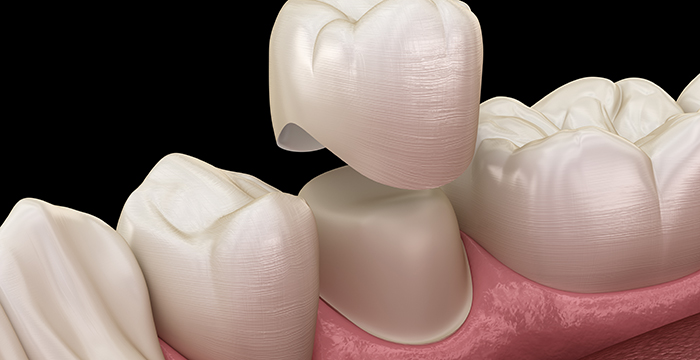Dental Crowns
What are All-Ceramic Crowns?

A crown is used to cap or completely cover a tooth being restored . All-Ceramic Crowns, as the name implies , do not contain other materials.
When are All-Ceramic Crowns my best choice?
Teeth are naturally translucent. Porcelain crowns fused to metal make it impossible to have a translucent restoration that mimics the natural teeth. Only All-Ceramic Crowns have such translucency.
All-ceramic crowns or caps offer a natural looking solution for a broken tooth, cracked tooth, or teeth that are too badly damaged to be corrected with fillings or veneers. Ceramic crowns can be made white and natural looking. Incorporating bonding with all-ceramic crowns potentially can restore both the strength and beauty of unblemished natural teeth.
What are the disadvantages of All-Ceramic crowns?
All-Ceramic Crowns are not as strong a porcelain fused to metal crowns. All-Ceramic Crowns require bonding to the existing tooth, and a dentist with expertise in this procedure.
No metal dental ceramic porcelains
Ceramic restorations have no metal and are totally made of ceramic glass, sometimes strengthened with a translucent material such as zirconium.
Feldspathic porcelain is the standard, traditional porcelain that is used for crowns. Many cosmetic dentists feel that this is the most beautiful porcelain.
Types of porcelain used in creating crowns:
Empress is, strictly speaking, not a porcelain, but more like a glass. Empress can be called a ceramic material. The Empress material is cast rather than baked, as a feldspathic porcelain crown is. The fit of Empress is more precise than the baked feldspathic porcelain. However, the color in Empress is mostly baked on the outside. Empress can be very beautiful. For appearance’s sake, some expert cosmetic dentists prefer the feldspathic porcelain, and some prefer the Empress.
Lava Zirconia is a milled ceramic on the inside with a more traditional porcelain baked onto the outside. The advantage of Lava is its exceptional strength. However, the milled ceramic core is opaque, so many cosmetic dentists feel that it isn’t as natural-looking as the more translucent materials. An advantage of Lava is that it doesn’t have to be bonded to the tooth but can be cemented with ordinary crown and bridge cement, a technique familiar to all dentists.
Procera is similar to Lava, but the milled ceramic on the inside is more translucent than an opaque white material. The Procera crown can also be cemented with traditional techniques. However, any crown cemented with a traditional crown and bridge cement is going to be susceptible to a compromise in the appearance if that cement line ever shows.
What other crown options are available for me?
Porcelain fused to gold offers a great cosmetic option for rear molars when strength of the restoration is a concern. We offer several Dental Crowns and Caps restorative options including porcelain crowns, inlays, and onlays.
My Scottsdale Dentist and Dr. Poulos, will help you decide which system is the most appropriate to achieve the strongest and the most natural looking crowns for your smile.
